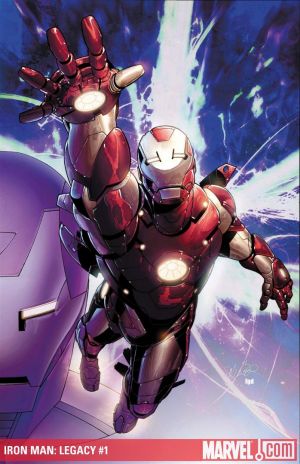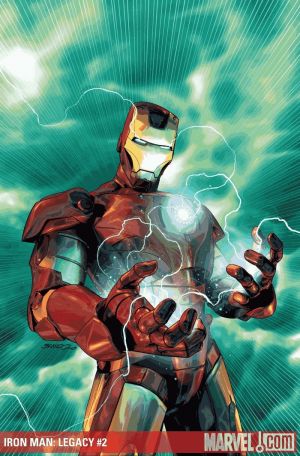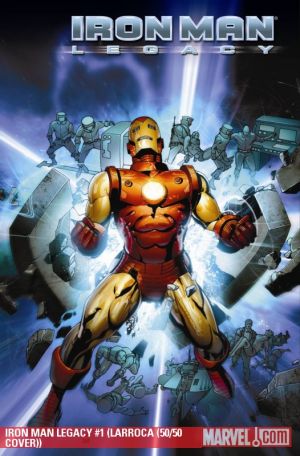- Comics
- Comics Reviews
- Manga
- Comics Reviews
- European Comics
- News
- Comics News
- Press Releases
- Columns
- Spotlight
- Digital Comics
- Webcomics
- Cult Favorite
- Back Issues
- Webcomics
- Movies
- Toys
- Store
- More
- About
By Andy Frisk
April 16, 2010 - 22:29
If you’re a fan of Iron Man or read the Armored Avenger’s exploits regularly or even irregularly, you’ll undoubtedly recognize this plot: Tony Stark, genius mechanical engineer and inventor, industrial tycoon, creator of the Iron Man armor, and hero has his technical designs for the aforementioned armor stolen through industrial espionage and replicated by evil men with destruction, greed, and power as their goals. Tony, feeling responsible and angry that his invention, the Iron Man tech, is being perverted and used for evil, goes on a personal crusade to reclaim and/or destroy his stolen and misused tech. Super hero and high tech action ensues along with some pretty good commentary on the evils of rampant greed, the abuse of resources that are meant to promote progress instead of destruction, and personal redemption. It’s a great tale that’s been told very well, and repeatedly, over the four decades of the hero’s existence in print, in cartoons, and on the silver screen. So why tell it again? The answer’s simple, it’s such a good story. Iron Man Legacy scribe Fred Van Lente is off to a darn good start launching an updated version of it. Set during a very real world political, horrific, and war torn time and region, “War of The Iron Men” might borrow an oft told tale’s theme, but Lente makes it his own and in many ways better than its previous incarnations.
 |
Set during what must be the early to mid 1990’s, the height of the ethic and genocidal Balkan wars between Serbia, Bosnia-Herzegovina, and Croatia, “War of The Iron Men” opens with (after a brief biographical interlude on Tony Stark) a protest of seemingly anti-corporate environmentalists protesting Stark’s new energy generating technology, the arc reactor (which fans will recognize from the first Iron Man movie). A group of the protestors, later revealed to be (in Tony's words) “mercenaries hired by Americans for Energy Awareness, the quote-unquote ‘grassroots’ group that organized today’s protest…which my (Stark’s) investigators found is funded by big oil lobbyists…who’d love to kill the Stark arc reactor and protect their own grossly inflated profits” turn violent and attack the Stark Industries compound where development of arc reactor tech is taking place. Iron Man is forced to intervene, and he apprehends the corporate terrorists. During Tony’s press conference deriding the attack and praising the benefits of arc reactor tech, the assembled media make Tony aware of atrocities being committed by paramilitaries using apparent Iron Man tech within the (fictional) former Balkan nation of Transia against Muslim Romani separatists. The assembled press’ attempt at a public hanging of Tony is cut short when Tony angrily ends the press conference. He immediately launches an investigation into how his tech has been pirated and what his options are on launching an intervention into Transia’s war in order to stop the atrocities. After concurring with various allies such as Jessica Drew, James Rhodey, Nick Fury, and in a “moment of clarity” scene with one of his wise beyond his station personal janitors later that night, Tony decides what he must do. Politics and consequences be damned, Tony Stark will put an end to this perversion of his technological advances which were designed to promote peace and progress as, of course, Iron Man…
Again, this storyline seems to be a rehash of a story that’s already been told, and has been derided as such by critics within sequential art circles, but upon closer inspection, what Van Lente is doing with this “tired” plot is incredibly fresh, intelligent, and, of course, relevant. As mentioned, “The War of The Iron Men” is apparently set during the mid 1990’s Balkan war crisis. This immediately alerts the reader to the fact that all is not as it appears superficially in Iron Man Legacy. The title of the series itself suggests that the series’ tales will deal with the future effects of our hero’s actions, inventions, and choices. A legacy is something that one leaves to future generations. By setting “War of the Iron Men” in the recent past, Van Lente plays with the idea of a legacy by taking it out of current time and continuity. Iron Man Legacy deals with the legacy that Tony’s invented tech can have, did have, and does have. By placing a story focused on the legacy of an eternally (albeit necessarily) contemporary character in the past, Van Lente opens up this series thematically to semi-continuity free stories that will enrich the legacy of one of Marvel Comics’ most politically charged and allegorically and metaphorically relevant (to American politics, economics, and values) characters without corrupting the character’s current continuity. In short, Iron Man Legacy has the potential to serve as an excellent jumping on point for new Iron Man fans as well as long term Iron Man fans who are hungry for deeping meaning in, and intelligent exploration of, their favorite character’s story’s themes.
 |
Van Lente does more than simply play witty word games with this new Iron Man series’ title. He seamlessly mixes sly commentary and a starkly blatant and derisively tinged reflection of current real world political events while addressing a multitude of tough questions that have, and will, face any well meaning industrialist, political movement, nation, or hero. The image of a protestor’s poster depicting Tony Stark’s face with a swastika branded upon his forehead is eerily similar to, and just as disturbingly ludicrous as, real life protest posters equating President Obama with the evil and despicable national socialist movement of Nazi Germany. Also, the depiction of liberal, environmentalist, and anti-corporate, but well meaning grassroots activists who are infiltrated and have their message abused by corporate terrorists is reflective of elements within the modern day Tea Party movement. Similarly, some Tea Parties are sponsored, have their message abused, and are corrupted by big pharmaceutical and insurance company lobbyists and their cronies who spread the “death panel” lies in an effort to derail health care reform while spreading misinformation on the truth about tax rates and fiscal policies through a blatant manipulation of real facts and figures. Finally, Van Lente addresses the idiotic actions and statements of ratings and sensationalism driven members of the press who label Tony Stark as “pro-genocide” before even determining the facts behind the Transian paramilitary group’s abuse of what is seemingly Stark Industries Iron Man tech. The tech being misused has only been proven to “resemble” Stark tech thus far.
Perhaps most importantly, Van Lente addresses the many consequences and considerations that inform a decision to act on behalf of a sense of justice and human decency and dignity on a global scale by Tony Stark/Iron Man and by proxy through metaphor, The United States. Tony Stark/Iron Man is as much a metaphor for America as Captain America is in the sense that Tony represents American ingenuity, industriousness, success, and free enterprise, guided by (sadly not as frequently as we’d like to believe in the real world) a sense of fairness and justice. In the early post Cold War years the real world atrocities, human rights violations, and rampant genocide that took place in the Balkans went unaddressed by the world’s only remaining superpower at first. Eventually, United Nations intervention, galvanized by The United States, stemmed the tide of bloodshed, but the death toll was unnecessarily high and political concerns (and necessary caution towards violating sovereignty-which has subsequently been abandoned-for better or worse in some cases) halted an immediate response towards the violence. In “War of The Iron Men Part One,” Tony takes decisive and direct action with his “damn the consequences” intervention in the Transian conflict out of a sense of duty and justice. The question of quick and direct intervention is raised by Tony’s action, but no judgment is made on its validity, at least not yet…
 |
You know that a new sequential art series must be worth checking out as an instantly classic and seminal work about a very interesting character when it doesn’t even get to the examination of its artwork until several paragraphs in. By this point in our look into Iron Man Legacy #1 the reader might be looking for things to start wrapping up, but it would be an injustice towards Steve Kurth and his fantastic artwork to neglect commenting upon it. Kurth does a great job capturing the necessary attention to detail and depiction of sci-fi, albeit real world based, high technology. His version of the Iron Man armor is sufficiently fantastic (in the older sense of the word) technologically, yet is realistic enough to have stepped off the silver screen (the movie version of the Iron Man armor and tech being the most realistic and fascinating depiction of it ever). Anatomy, choreography, panel layout, and perception are all easily mastered by Kurth. His depiction of the large screen feed of the atrocities in Transia is particularly well done. He bonds our perception of the moment we learn of this harrowing genocide with the moment Tony Stark learns of it masterfully, putting us as readers emotionally in Tony’s shoes and creating the necessary bond with our protagonist that enables us to emotionally experience and understand his reactions. This is an example of the power of sequential art done right. It bonds the reader, character, and story uniquely.
Iron Man Legacy is a great example of how great sequential art characters in great writer’s hands can remain timeless and poignant, even if the story being told has been told before in some shape or form. One of the true signs of great art or literature is the ability of the author to present familiar ideas, themes, and stories in new and relevant ways. Iron Man Legacy definitely looks to be up to the challenge of meeting this requirement in the able hands of Van Lente and company.
Rating: 10 /10